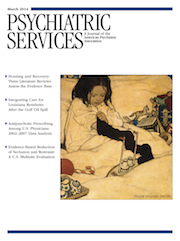Services for Adolescents With Psychiatric Disorders: 12-Month Data From the National Comorbidity Survey–Adolescent
Abstract
Objective
This study examined 12-month rates of service use for mental, emotional, and behavioral disorders among adolescents.
Methods
Data were from the National Comorbidity Survey Adolescent Supplement (NCS-A), a survey of DSM-IV mental, emotional, and behavioral disorders and service use.
Results
In the past 12 months, 45.0% of adolescents with psychiatric disorders received some form of service. The most likely were those with ADHD (73.8%), conduct disorder (73.4%), or oppositional defiant disorder (71.0%). Least likely were those with specific phobias (40.7%) and any anxiety disorder (41.4%). Among those with any disorder, services were more likely to be received in a school setting (23.6%) or in a specialty mental health setting (22.8%) than in a general medical setting (10.1%). Youths with any disorder also received services in juvenile justice settings (4.5%), complementary and alternative medicine (5.3%), and human services settings (7.9%). Although general medical providers treated a larger proportion of youths with mood disorders than with behavior disorders, they were more likely to treat youths with behavior disorders because of the larger number of the latter (11.5% of 1,465 versus 13.9% of 820). Black youths were significantly less likely than white youths to receive specialty mental health or general medical services for mental disorders.
Conclusions
Findings from this analysis of NCS-A data confirm those of earlier, smaller studies, that only a minority of youths with psychiatric disorders receive treatment of any sort. Much of this treatment was provided in service settings in which few providers were likely to have specialist mental health training.



